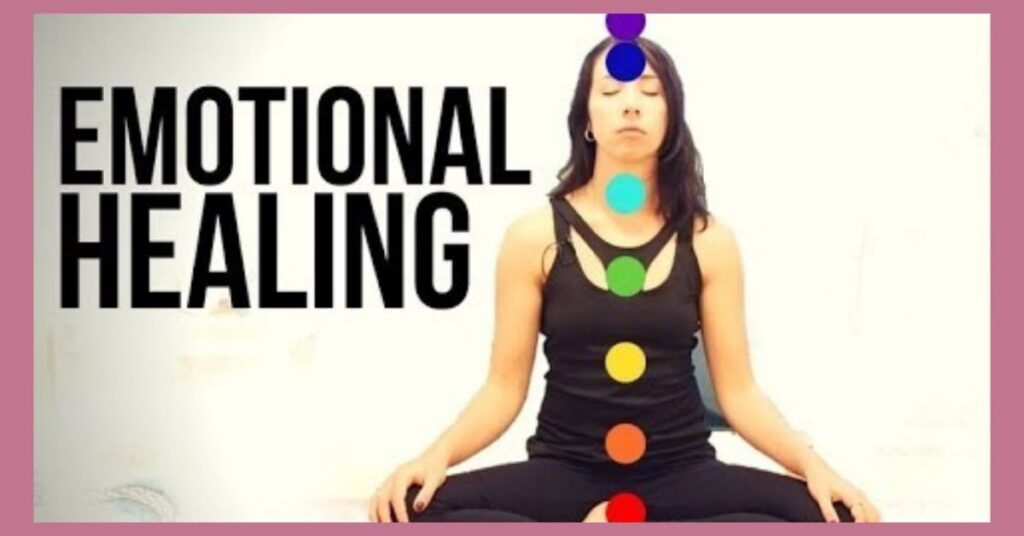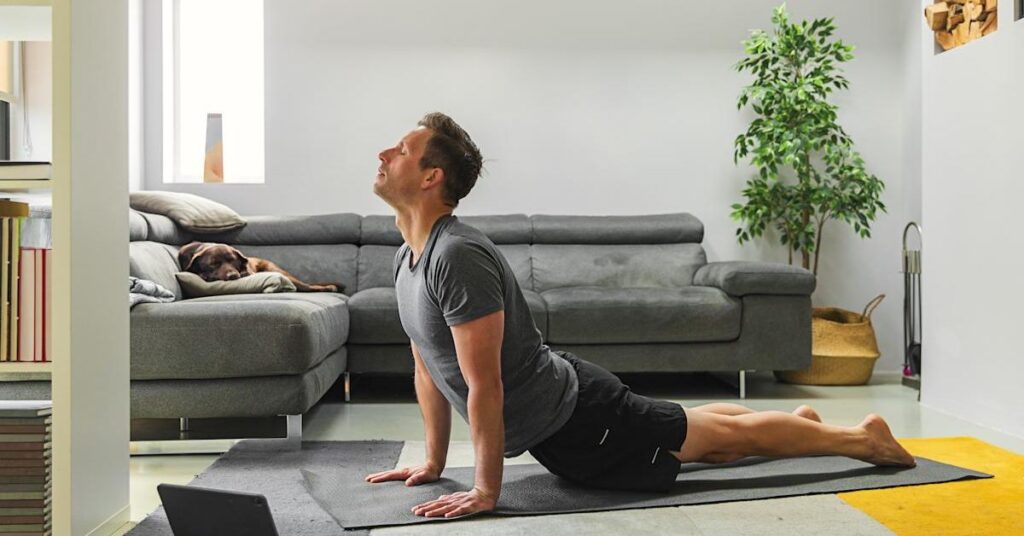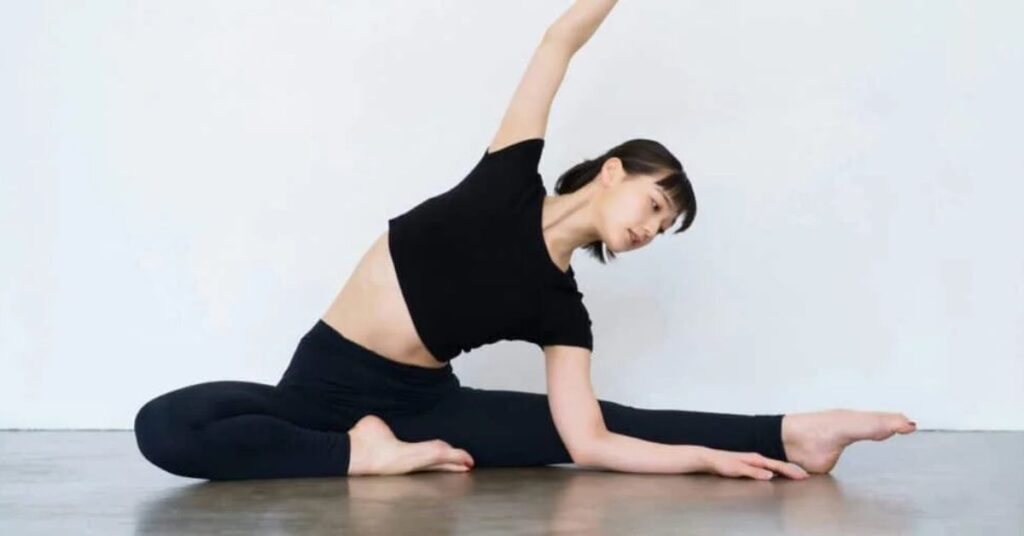This article will explain what somatic yoga is and its benefits for beginners. It also includes 10 simple and effective somatic yoga exercises for beginners. Somatic yoga is an exercise that emphasizes mindfulness and self-awareness. Somatic yoga is different from traditional yoga, which focuses on perfect alignment and mastering difficult poses. It focuses more on listening to the body, feeling its sensations, and honouring what it needs at the moment.
Somatic yoga is a practice that encourages the exploration of physical sensations. These experiences can include tension, heat, coolness, or tightness. The experiences could also include the flow of your breath. This practice encourages you to become aware of your feelings and cultivate compassion.
Somatic yoga brings awareness to the internal landscape of your body through slow, deliberate movements. The energy, feelings, and emotions that arise during practice are as important as the movements. Somatic yoga offers a safe environment to explore your body and heal it, allowing you to restore balance and make peace with yourself.
The Transformative Benefits of Somatic Yoga

Somatic yoga has many benefits that go beyond the physical. It is a powerful practice that works on many levels, including physical, mental, and emotional. The practice allows you to experience holistic health. We’ll explore some of its key benefits below:
1. Stress and Anxiety Relief
Somatic yoga can be a very effective way to reduce stress and anxiety. When stressed, the body tends to hold tension in different areas. Such tension can cause discomfort and illness. Somatic yoga encourages relaxation through mindful breathing and gentle movement. Here’s how:
- Activates Relaxation Response: Somatic yoga helps the body shift from “fight or flight” (sympathetic system) into the “rest-and-digest” state (parasympathetic system). This shift reduces cortisol, the main stress hormone.
- Improved Breathing: Paying attention to your breathing during the practice activates the parasympathetic nervous system. This procedure allows your body to recharge and rest.
- Releases Muscle Tension: By using slow movements, you can release the tension that has built up in your muscles. Your body will feel lighter and more relaxed.
2. Emotional Release and Healing

Emotions are often trapped in the body, causing tension, discomfort, or chronic pain. Somatic yoga releases these emotions and emotional blockages, allowing emotional healing and resilience.
- Releases Repressed Feelings: When emotions like sadness, anger, or fear are suppressed, they can manifest in the body. Somatic yoga allows you to explore these emotions and creates a safe environment for emotional release.
- Promotes emotional resilience: You can strengthen your emotional resilience by acknowledging and processing your emotions through mindful movements. You will also learn how to respond with compassion and not repression.
3. Chronic Pain Relief
Many people experience chronic pain as a result of past injuries, emotional trauma, or long-term tension. Somatic yoga is a gentle method to treat the underlying causes of chronic pain.
- It addresses both the physical and emotional causes of pain: Chronic pain is often accompanied by an emotional component such as unresolved trauma or stress. You can release emotional and mental factors that contribute to pain through somatic yoga.
- Promotes self-compassion: Somatic yoga encourages you to have compassion for your body, its sensations, and pain. Such an attitude can lead to a reduction in pain and an increase in comfort.
4. Improved Flexibility and Mobility

It can improve your flexibility and mobility if you are spending a lot of time in a single posture, such as sitting at a desk for many hours. It trains your nervous system to respond more easily to gentle movements.
- Somatic yoga helps to correct movement patterns: Using mindful movement can help correct movement patterns such as bad posture or tight muscles that have been developed over time.
- Increases Joint Mobility: By moving slowly and deliberately, you improve the range of motion in your joints, which enhances overall mobility and flexibility.
10 Somatic Yoga Exercises for Beginners

Let’s now explore some somatic exercises to help you get started. These exercises for beginners are designed to promote relaxation and emotional release as well as increased body awareness.
1. Full Body Scan
This is the perfect exercise to begin your somatic practice of yoga by tuning in to your body’s sensations.
How to do it:
- Lie on your back, legs extended and arms at your sides.
- Close your eyes and start scanning your body from the bottom up.
- Breathe into the areas where you feel tension to relieve it.
- Allow your body to fully relax by staying in this position for 10-20 minutes.
2. Moving Bridge
The moving bridge improves spinal mobility and helps to release tension from your lower back, glutes, and lower back.
How to:
- Lie on your back with your legs bent and your feet flat on the ground.
- Slowly raise your hips, rolling one vertebra up at a time.
- Hold the bridge position for a few deep breaths and then lower your back slowly to the floor.
- Repeat the movements several times. Focus on your hips and spine.
3. Knee Rock With Cactus Arms
This gentle movement releases tension from the lower back and hips.
How to:
- Lie on your back and place your arms in the cactus position.
- Rock your knees slowly from side to side while synchronizing your breath.
Feel the gentle stretching and movement of your hips and lower spine.
4. Half Wind Removing Pose
This pose promotes flexibility and strength by stretching the hips, activating the core muscles, and strengthening the core.
How to:
- Lean back and bend your knees.
- Hold your knee with both hands and bring one knee to your chest.
- You can also extend your opposite leg and focus on the hip flexor stretch.
- Hold your position for a few seconds, then change sides.
5. Seated Torso Circles
This exercise promotes spinal mobility and helps release tension from the spine.
How to:
- Position yourself cross-legged, placing your hands on your knees.
- Draw slow circles in both directions with your torso.
- As you turn, focus on the movement of your hips and spine.
6. Seated Side Stretch
This stretch increases flexibility and reduces tension in your lower back.
How to:
- Sit comfortably and raise one arm above your head.
- Slowly lean sideways, feeling the stretch along your side.
- Breathe in deeply and allow your body to relax.
7. Sphinx Pose with Half Frog
This combination of poses promotes relaxation by opening the hips, spine, and chest.
How to:
- Start with the Sphinx pose, with your chest raised and forearms lifted.
- Half Frog: Bend one knee gently and then move it to the side.
- Inhale deeply and stretch out your limbs.
8. Extended Child’s Pose With Pandiculation
This pose helps relax your body by stretching your back and hips.
How to:
- Start in the Child’s Pose, with your legs apart and your chest towards the ground.
- Stretch your arms out and lengthen your spine.
- To release tension, stretch your body slowly in a cat-like manner.
9. Gentle Neck Circles
This exercise is excellent for releasing tension in the neck and shoulders.
How to do it:
- Sit comfortably and gently circle your head, first in one direction and then the other.
- Focus on releasing tension in the neck and shoulders as you move.
Final Thoughts: Begin Your Somatic Yoga Journey Today
Somatic yoga is a powerful practice that helps you reconnect with your body and release tension. It also allows you to heal emotionally. Somatic yoga is a powerful way to transform your life, whether you are dealing with chronic pain or stress.
Yoga is about listening to your body and moving with compassion and mindfulness. You’ll experience profound benefits if you allow yourself to explore, heal, and release at your own pace.
You’ll not only improve your flexibility and strength, but you’ll also foster a more compassionate, more profound relationship with your mind, body, and emotions. Are you ready to start? Your body is ready to go.
